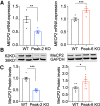Identification and characterization of conserved noncoding cis-regulatory elements that impact Mecp2 expression and neurological functions
- PMID: 33737384
- PMCID: PMC8015713
- DOI: 10.1101/gad.345397.120
Identification and characterization of conserved noncoding cis-regulatory elements that impact Mecp2 expression and neurological functions
Abstract
While changes in MeCP2 dosage cause Rett syndrome (RTT) and MECP2 duplication syndrome (MDS), its transcriptional regulation is poorly understood. Here, we identified six putative noncoding regulatory elements of Mecp2, two of which are conserved in humans. Upon deletion in mice and human iPSC-derived neurons, these elements altered RNA and protein levels in opposite directions and resulted in a subset of RTT- and MDS-like behavioral deficits in mice. Our discovery provides insight into transcriptional regulation of Mecp2/MECP2 and highlights genomic sites that could serve as diagnostic and therapeutic targets in RTT or MDS.
Keywords: MeCP2; cis-regulatory elements; neurological disorders; noncoding.
© 2021 Shao et al.; Published by Cold Spring Harbor Laboratory Press.
Figures





References
Publication types
MeSH terms
Substances
Supplementary concepts
Grants and funding
LinkOut - more resources
Full Text Sources
Other Literature Sources
Medical
Molecular Biology Databases
Research Materials
Miscellaneous
